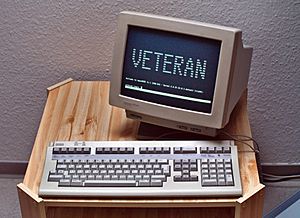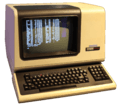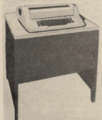Computer terminal facts for kids
A computer terminal is a special device that lets you interact with a larger, central computer system. Think of it like a window and a keyboard that connects you to a powerful computer, often called a "host computer." It usually has a screen to show you information and a keyboard to type in commands or data. Terminals were very important in the early days of computing, allowing many people to share one big computer.
Contents
What is a Computer Terminal?
A computer terminal acts as an input and output device. This means it takes information you type (input) and shows you results on the screen (output). It doesn't usually do much processing on its own. Instead, it sends your commands to the main computer, which then does the heavy work and sends the results back to your terminal to display.
How Terminals Work
When you type on a terminal's keyboard, your keystrokes are sent as electrical signals or data packets to the host computer. The host computer processes these signals, runs programs, and then sends back information to the terminal. The terminal then displays this information on its screen. This connection can be through cables or even over networks.
Types of Terminals
Over time, different kinds of terminals were developed:
Dumb Terminals
The earliest and simplest terminals were called dumb terminals. They had no processing power or memory of their own. Their only job was to send what you typed to the host computer and display what the host computer sent back. They were just a basic connection point.
Smart Terminals
Later, smart terminals or intelligent terminals appeared. These terminals had their own small CPU (like a tiny brain) and some memory. This allowed them to do basic tasks on their own, like checking for typing errors or formatting text, before sending data to the main computer. This made the whole system work faster because the host computer didn't have to do every tiny job. Some smart terminals could even be programmed to do specific tasks independently.
Terminals in History
Computer terminals were very common from the 1960s to the 1980s. Before personal computers became popular, terminals were the main way people accessed powerful computers. For example, many businesses, universities, and government offices used terminals for data entry, programming, and accessing large databases.
Early terminals often looked like typewriters with screens. Some, like the Teletype Model 33, even printed everything on paper. As technology improved, screens became standard, and terminals became more advanced, leading to the development of personal computers we use today. Even now, modern computers often use "terminal emulators" – special programs that pretend to be old-fashioned terminals – to access remote servers or run certain types of software.
Images for kids
-
A Televideo ASCII character mode terminal
See also
 In Spanish: Terminal (informática) para niños
In Spanish: Terminal (informática) para niños








